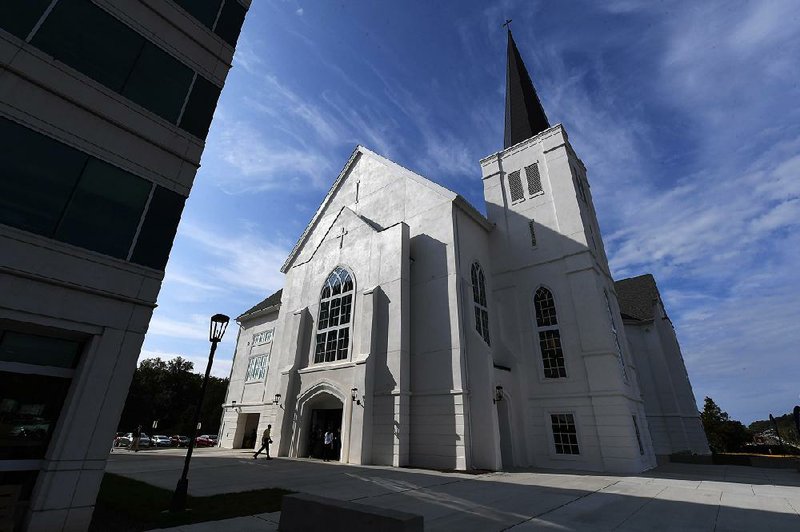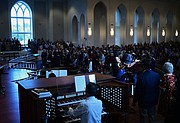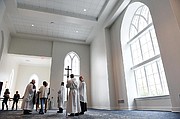FALLS CHURCH, Va. -- The Falls Church -- the church that is such a landmark that the northern Virginia city was named for the congregation -- is for the first time in its nearly 300-year history two separate churches in two buildings.
The church began splintering in 2006, when members voted to leave their Episcopal denomination because it had appointed a gay bishop. What followed was a bitter court battle and a split into two congregations -- one small and liberal, the other large and conservative.
And after seven years of wandering for the large group, what followed Sunday as congregants walked in for their sixth service in their new building was a collective sigh of "Finally!" as they looked out over the 968 seats in the pews of the long, white sanctuary.
The Falls Church Anglican -- the name used by the congregation that broke away from the Episcopal Church -- is settling into its new home on Arlington Boulevard in Fairfax County. The congregation raised millions to create a new church after losing its fight to keep the historic Falls Church building, the iconic brick structure where George Washington worshipped.
It was a case that made national headlines. Church observers saw the court's decision as a harbinger for bitterly divided congregations across many of the nation's denominations amid a worldwide struggle between conservative and liberal theology.
But this month, as the Falls Church Anglican celebrates its new home, members speak enthusiastically about their new location, rather than bitterly about what they lost.
"I know it was the right choice," longtime member Steve Uphill said. "Seven is completion. It took seven years for us to get through this."
"It was such a long time coming," Penny Snare said. "It already feels like home in so many ways."
The church bought a $31 million, five-acre property with a five-story office building and is generating income (on which it pays taxes, unlike on donations by parishioners) by renting out space to the building's tenants, most of which are medical offices. The Falls Church Anglican added a parking garage, which the Rev. Sam Ferguson said cost more than $9 million, and the approximately 20,000-square-foot church building, which Ferguson said cost $17 million to build.
This is a deep-pocketed congregation. But unlike many religious buildings funded by wealthy donors, no one's names are on the walls at the Falls Church Anglican. There are no plaques or rooms named for those who donated money.
Ferguson said that was a choice, just like the decision to have plain windows instead of stained glass on the busy boulevard where the church sits. "We want people to see what's going on and feel very welcome," he said.
The church is just south of the building where the group began, but while that neighborhood was predominantly white and wealthy (like this congregation and Episcopalians nationwide, on average), their new location is in a neighborhood popular with recent immigrants.
"It seems like a mile, but it's really a different world," Ferguson said. The church plans to offer live Spanish translation during services, starting with once a month. "We want to be a church where five years from now, our neighbors are glad we're here, rather than just indifferent or even discouraged that we create a traffic jam on Sunday mornings."
Jennifer Parker, a longtime member, said one of her hopes for the new building is that the congregation becomes significantly more racially diverse. "This is so beautiful," she said. "This is the new place God has for us. This is a place of blessing."
In 2006, members of the Falls Church voted overwhelmingly to leave the Episcopal Church. The deciding factor was the appointment of a gay man as a bishop.
"The ordination of a practicing homosexual as bishop was the flashpoint that showed how far the repudiation of Christian orthodoxy had gone," the Rev. John Yates wrote at the time. Nowadays, Ferguson and members of his church say that it was the right decision, although they tend to emphasize that it wasn't just about the presence of a gay man in church leadership.
"The Episcopal Church -- I believe they take their cues more from culture than Scripture," said Parker's son, David Parker. "For us, there's only been one way we believe is the way. And that's not a popular belief anymore."
The Episcopal Church is the United States' incarnation of the Church of England. The breakaway Falls Church congregation, along with a handful of other Virginia churches, came up with a novel workaround. They chose to abandon the U.S. church and instead come under the leadership of an Anglican bishop in Nigeria, who had gone so far as to endorse a law that would make gay sex punishable by imprisonment.
Today, the Falls Church Anglican is one of more than 1,600 churches in North America that identify as "Anglican," not "Episcopal" -- a new evangelical denomination that rejects the Episcopal embrace of LGBT inclusion but maintains similar liturgy.
The Virginia churches that broke away argued that they, not their denomination, should keep their buildings and bank accounts. The denomination argued that individual members -- even most of the members of a particular church -- could choose to leave a church at any time but couldn't take with them the property that belonged to the Episcopal Diocese of Virginia.
The Falls Church Anglican fought the case longer than any other in Virginia. In 2012, the state Supreme Court sided with the Episcopal diocese, and the Anglicans moved out, meeting in temporary spaces including a Catholic high school auditorium.
That left the Episcopal Church the owners of a historic building in need of a congregation.
Just 35 people had decided to remain Falls Church Episcopalians when the church split. During the years of the court battle, that number grew to 80, who moved back into the contested building when the ruling came down in their favor.
It was far too small a group, they knew, to support a space that had recently housed 2,000 every Sunday.
Today, the Falls Church Episcopal, less than a mile from the new building of its conservative counterpart, has almost 600 members, according to the Rev. John Ohmer, who has been rector since 2012 but recently announced he will leave for another church position.
"It's a very large space for a relatively small group of people. I've learned to not look at the empty chairs. I've learned to look at the people," Ohmer said.
The small group manages the financial burden of the large church, he said, by renting out the building that was once the church's education wing as retail space, and by spending the interest generated by the once-contested $2 million bank account that the Virginia courts ruled belonged to the Episcopal Church.
The Falls Church Anglican shrank from about 2,000 worshippers each week to about 1,200 in the years without a building. Some of those members left for the six new Anglican churches that this congregation has helped launch throughout the region.
Ferguson hopes the new space will attract new and larger crowds. And he is awed to have made it to this point: "If you just drove up to a church," he mused, "with 2,000 members, 55 staff, and you said, 'If they lose everything, do you think they'll still be together in seven years?' You'd say, 'No way. Not a chance.'"
The new spire overlooking Arlington Boulevard says otherwise.
Religion on 10/19/2019


